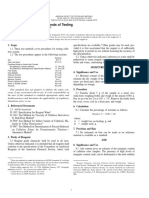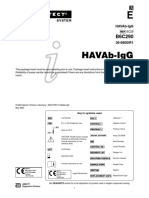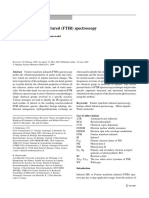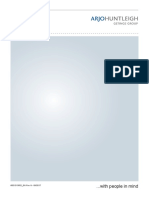T4 Iflash
T4 Iflash
Uploaded by
NIGHT tubeCopyright:
Available Formats
T4 Iflash
T4 Iflash
Uploaded by
NIGHT tubeOriginal Title
Copyright
Available Formats
Share this document
Did you find this document useful?
Is this content inappropriate?
Copyright:
Available Formats
T4 Iflash
T4 Iflash
Uploaded by
NIGHT tubeCopyright:
Available Formats
T4 iFlash
Immunoassay Analyzer
T4 acridinium-ester-labeled conjugate, 4.0
REF C86026 R2
2×50 Tests mL/pack, 0.05% ProClin 300.
Sample processing solution, 4.0 mL/pack,
INTENDED USE R3 8-anilino-1-naphthalenesulfonic acid
magnesium, 0.05% ProClin 300.
The iFlash-T4 assay is a paramagnetic particle
chemiluminescent immunoassay (CLIA) for the Calibrator 1, 1 bottle, 1.0 mL, Phosphate
quantitative determination of Total thyroxine (T4) in human CAL1 buffer with protein stabilizers, 0.05% ProClin
serum and plasma using the iFlash Immunoassay 300.
Analyzer.
Calibrator 2, 1 bottle, 1.0 mL, T4 in
SUMMARY AND EXPLANATION CAL2 Phosphate buffer with protein stabilizers,
Thyroxine (T4) is a hormone synthesized and secreted by 0.05% ProClin 300.
the thyroid gland, and plays an important role in regulating
Calibrator 3, 1 bottle, 1.0 mL, T4 in
metabolism system. T4 is secreted into the circulation in CAL3 Phosphate buffer with protein stabilizers,
response to the pituitary hormone TSH (thyroid stimulating 0.05% ProClin 300.
hormone). T4 and its associate thyroid hormone T3 are
responsible for regulating diverse biochemical processes Calibrator 4, 1 bottle, 1.0 mL, T4 in
throughout the body that are essential for normal CAL4 Phosphate buffer with protein stabilizers,
metabolic and neural activity. 0.05% ProClin 300.
The determination of T4 can be utilized for the following
indications: the detection of hyperthyroidism, the detection MATERIALS REQUIRED (BUT NOT PROVIDED)
of primary and secondary hypothyroidism and the REF C89999/C89959/C89949, iFlash Pre-Trigger
monitoring of TSH-suppression therapy. Solution: hydrogen peroxide solution.
REF C89998/ C89958/ C89948, iFlash Trigger Solution:
ASSAY PRINCIPLE
sodium hydroxide solution.
The iFlash-T4 assay is a competitive immunoassay.
REF C89997, iFlash Wash Buffer: phosphate buffered
First incubation: T4 in the sample react with sample
saline solution with 0.05% ProClin 300.
processing solution, T4 is released.
REF C80001, iFlash Wash Buffer (10×): phosphate
Second incubation: Add the acridinium-ester-labeled
buffered saline solution with 0.05% ProClin 300.
T4 conjugate and anti-T4 antibody coated
REF C89996, reaction vessels.
paramagnetic microparticles. T4 in the sample and the
acridinium-ester-labeled T4 conjugate can react with Controls: Commercial controls could be used.
anti-T4 antibody competitively, to form a complex of
WARNINGS AND PRECAUTIONS
antibody and acridinium-ester-labeled antigen.
IVD For in vitro diagnostic use
Wash: The unbound materials are washed away from
iFlash Trigger solution contains sodium hydroxide
the solid phase in a magnetic field.
(NaOH) and should be avoided contact with eyes.
Trigger of signal: The Pre-Trigger and Trigger
Exercise the normal precautions required for handling
Solutions are added to the reaction mixture. The
all laboratory reagents.
resulting chemiluminescent reaction is measured as
relative light units (RLUs). Disposal of all waste material should be in accordance
with local guidelines.
An inversely proportional relationship exists between
the amount of T4 in the sample and the RLUs detected Wear gloves when handling specimens or reagents.
by the iFlash optical system. Clean and disinfect all spills of specimens or reagents
Results are determined via a calibration curve, which using a suitable disinfectant.
is instrument-specifically generated by 4-point
REAGENT HANDLING
calibration and a master curve provided via the
reagent QR code. The reagents may not be used after the stated
expiration date.
REAGENTS Avoid the formation of foam with all reagents.
Reagent kit, 100 tests, 2 packs, 50 tests/pack The reagents in the pack and calibrators are ready for
use. Close the bottles of calibrator right after
Anti-T4 antibody coated paramagnetic
R1 microparticles, 3.5 mL/pack, 0.05% ProClin calibration and store at 2 ~ 8°C.
300. Do not pool reagents within a reagent kit or between
reagent kits.
1/4 V2.0 English Ed.2018-02-01
T4 iFlash
Immunoassay Analyzer
Prior to loading the iFlash-T4 reagent pack on the help system for detailed information on preparing the
system for the first time, resuspend the microparticles system.
by inverting the reagent pack slightly. The test-specific parameters stored in barcode on the
For further information on reagent handling reagent pack are read in. In case the barcode cannot
precautions during system operation, refer to the be read, enter the sequence numbers.
iFlash system operating instruction. Carry out calibration, if necessary.
STORAGE AND STABILITY Place the calibrators CAL1, CAL2, CAL3 and CAL4in
the calibrator rack in the sample zone. Only keep
Storage: calibrators open during calibration.
Store at 2–8°C in an upright position. Test application.
The kit may be used immediately after removal from 2 Loading samples (Use 20 μL of sample for each
~ 8°C storage. determination in addition to the sample container and
system dead volumes).
Stability:
Click RUN, the iFlash System performs all the
Unopened at 2 ~ 8°C: up to the stated expiration date.
functions automatically and calculates the results.
Opened at 2 ~ 8°C: 28 days.
Store on-board: 28 days. Alternate Result Unit
Conversion formula:
SPECIMEN COLLECTION AND PREPARATION
(Concentration in YHLO Unit) x (Conversion Factor) =
Serum or plasma (lithium heparin, sodium heparin
(Concentration in Standard Unit)
potassium EDTA, and sodium citrate) are the
recommended samples. Other anticoagulants have YHLO Unit Conversion Factor Standard
not been validated for use with the iFlash-T4 assay. Unit
Ensure that serum specimens to form complete clot
prior to centrifugation. (Clotting time is not less than 1 ng/mL 1.287 nmol/L
hour).
Centrifuge the specimens.
CALIBRATION
Store specimens at room temperature (20 to 25°C) for
no longer than 8 hours. Traceability: This kit calibrator is traceable to the
Chinese Academy of Food and Drug test T4 standard.
If the testing will not be completed within 8 hours,
refrigerate the samples at 2 to 8°C. Every iFlash-T4 reagent kit has a QR code label
containing the specific information for calibration of the
If the testing will not be completed within 3 days, or for
particular reagent lot.
shipment of samples, freeze at -20°C or colder.
To perform an iFlash-T4 calibration, test CAL1, CAL2,
Frozen specimens must be mixed thoroughly after
CAL3 and CAL4 in duplicate, and the predefined
thawing.
master curve is adapted to the analyzer.
The samples may be frozen for maximum 1 time.
Once an iFlash-T4 calibration is accepted and stored,
Centrifuge specimens with a lipid layer on the top, and all subsequent samples may be tested without further
transfer only the clarified specimen without the lipemic calibration unless:
material.
After 28 days when using the same reagent lot.
Ensure that residual fibrin and cellular matter have
A reagent kit with a new lot number is used.
been removed prior to analysis.
Controls are out of range.
Use with caution in handling patient specimens to
prevent cross-contamination. Required by pertinent regulations.
Do not use heat-inactivated samples. MEASURING RANGE
Ensure that the patient samples, calibrators and 5 ~ 300 ng/mL
controls are at ambient temperature (20 ~ 25°C)
before measurement. QUALITY CONTROL
Due to the possible evaporation, specimens and Quality control materials should be run as single
calibrators on the analyzers should be measured determinations at least once every 24 hours when the test
within 2 hours. is in use, once per reagent kit and after every calibration.
Include commercially available quality control materials
ASSAY PROCEDURE that cover at least two levels of analyte. Follow
Refer to the system operating instruction or the online manufacturer’s instructions for reconstitution and storage.
2/4 V2.0 English Ed.2018-02-01
T4 iFlash
Immunoassay Analyzer
Each laboratory should establish mean values and Precision
acceptable ranges to assure proper performance. Quality The precision of iFlash-T4 was determined using T4
control results that do not fall within acceptable ranges reagents and controls. Two controls, consisting low, and
may indicate invalid test results. median concentration of T4 were assayed.
RESULT The within run precision was determined by testing each
sample in replicates of 10 (n = 10), and calculating percent
Calculation: coefficient of variation (%CV). The results of the study are
The iFlash system automatically calculates the analyte shown below:
concentration of each sample. The results are given in Sample Mean (ng/mL) SD %CV
ng/mL.
1 18.72 0.89 4.76
Expected Values:
A study of iFlash-T4 assay on samples from 295 2 99.13 4.61 4.65
apparently healthy people of various age groups yielded
The between run precision was determined by testing
the following result:
th th each sample in duplicate, two separate runs daily for 20
45 ~ 126 ng /mL (2.5 ~ 97.5 percentile)
days (n = 80), and calculating percent coefficient of
It is recommended that each laboratory establish its own variation (%CV). The results of the study are shown
expected reference range for the specific population. below:
LIMITATIONS Sample Mean (ng/mL) SD %CV
The iFlash-T4 assay is limited to the determination of 1 18.25 0.79 4.35
T3 in human serum or plasma (lithium heparin, sodium
heparin, potassium EDTA, and sodium citrate). It has 2 100.44 4.93 4.91
not been validated for use with other types of plasma.
The use of serum separator (gel) blood collection Analytical Sensitivity
tubes has been validated for use with this assay. The detection limit representing the lowest measurable
However, it is not possible to survey all manufacturers analyte level is 5 ng/mL, which can be distinguished from
or tube types. zero. It is calculated as the value lying two standard
The upper limit of the measuring range of this assay is deviations above that of the lowest standard of the master
300 ng/mL. For the over-range samples, it is curve (standard 1 + 2 SD, n = 20).
suggested that using washing buffer 1:2 dilution. If
using manual dilution, the results should be multiplied Method Comparison
by the dilution multiple. The biggest dilution ratio is not A comparison of the iFlash-T4 assay (y) with a
less than 1:5. commercially available T4 assay (x) using clinical samples
If the results are inconsistent with clinical evidence, was performed, and the curve is fitted with Linear
additional testing is suggested to confirm the result. regression)
Specimens from heparinized patients may be partially y = 1.013x +9.690
coagulated and erroneous results could occur due to r = 0.9945
the presence of fibrin. Sample concentration: 6.00 ~ 300 ng/mL
The results from an alternative assays (i.e. EIA or RIA) Number of samples measured: 90
may not be equivalent and cannot be used
interchangeably. REFERENCES
The assay is unaffected by icterus (bilirubin < 10 1. Gornall, AG, Luxton, AW, Bhavnani, BR. Endocrine
mg/dL), hemolysis (Hb < 500 mg/dL), lipemia (Intralipid disorders in applied biochemistry of clinical disorders,
< 1,800 mg/dL). 305–318. Edited by Gornall, AG Philadelphia, PA: J B
Lippincott Co, 1986.
No interference was observed from rheumatoid factors
up to a concentration of 2,400 IU/mL. 2. White, GH, Recent advances in routine thyroid
function testing, CRC – Critical Reviews in Clinical
No interference was observed from anti-nuclear
Laboratory Sciences, 24: 315-362: 1987.
antibodies up to a concentration of 500 U/mL.
3. Wilke, TJ. Estimation of free thyroid hormone
No interference was observed from HAMA up to a
concentrations in the clinical laboratory. Clinical
concentration of 600 ng/mL.
Chemistry. 1986;32 (4): 585-592.
PERFORMANCE CHARACTERISTICS 4. Spencer, CA. Thyroid status: trends in testing –
Below are the representative performance data, and the selective test use cuts cost. Clinical Chemistry News.
results obtained in individual laboratories may differ. November,1989; 15 (11): 9-14.
3/4 V2.0 English Ed.2018-02-01
T4 iFlash
Immunoassay Analyzer
5. Liewendahl, K, Majuri, H, Helenius, T. Thyroid function ANNEX A:
tests in patients on long-term treatment with various Explanation of abbreviation
anticonvulsant drugs. Clinical Endocrinology, 1978; 8:
187-191. Abbreviation Explanation
6. Wenzel, KW. Pharmacological interference with in vitro
tests of thyroid function. Metabolis. 1981; 30 (7): Product No.
717-732.
Calibrator
SHENZHEN YHLO BIOTECH CO., LTD.
Reagent
1st-4th Floor, No.5 Building, Lishan Industrial
Area, Xinghai Road, Nanshan District,
Shenzhen 518054, P.R. China Number of tests
Wellkang Ltd (www.CE-marking.eu) Manufactured by
Suite B, 29 Harley St., London W1G 9QR, UK
EU Representative
EC Declaration of Conformity
Caution
Instructions for use
In vitro diagnostic medical
device
Lot No.
Date of manufacture
Expiry date
Biohazard Symbol
Pictograms for Caution
Pictograms for Hazardous to the
aquatic environment
4/4 V2.0 English Ed.2018-02-01
You might also like
- كتاب الوافى فيزياء اولى ثانوى ترم اولDocument49 pagesكتاب الوافى فيزياء اولى ثانوى ترم اولNIGHT tubeNo ratings yet
- JCE General Science Paper 1Document13 pagesJCE General Science Paper 1Thabang ModukaNo ratings yet
- Astm D 871 - 96Document12 pagesAstm D 871 - 96sukhoi474614No ratings yet
- GCP Vol 1 PDF (2022 Edition)Document436 pagesGCP Vol 1 PDF (2022 Edition)Sergio AlvaradoNo ratings yet
- Malmo Foods Final ReportDocument72 pagesMalmo Foods Final ReportFO PU75% (4)
- Hydraulic Pressure Control Valves - OOVAL - Product CatalogDocument16 pagesHydraulic Pressure Control Valves - OOVAL - Product CatalogIsrael Exporter100% (2)
- Totalt4 ArcDocument6 pagesTotalt4 Arctesteste testeNo ratings yet
- Anti TPODocument4 pagesAnti TPONIGHT tubeNo ratings yet
- Ft3 IflashDocument4 pagesFt3 IflashNIGHT tube100% (1)
- Elecsys T4: Cobas e 411 Cobas e 601 Cobas e 602 English System InformationDocument5 pagesElecsys T4: Cobas e 411 Cobas e 601 Cobas e 602 English System InformationIsmael CulquiNo ratings yet
- LH IflashDocument4 pagesLH IflashNIGHT tubeNo ratings yet
- Anti TSHRDocument4 pagesAnti TSHRNIGHT tube100% (1)
- Elecsys BRAHMS PCT: ProcalcitoninDocument5 pagesElecsys BRAHMS PCT: ProcalcitoninDóra BenczeNo ratings yet
- Free PSADocument4 pagesFree PSANIGHT tubeNo ratings yet
- Totalt3 ArcDocument6 pagesTotalt3 ArcTanveerNo ratings yet
- CREJ2Document4 pagesCREJ2ARIF AHAMMED PNo ratings yet
- Anti-TG ARCDocument7 pagesAnti-TG ARCMariaNo ratings yet
- RF Factor Reumatico MindrayDocument33 pagesRF Factor Reumatico Mindrayjcpc272005No ratings yet
- BS-800M BS-800M: Clinical Chemistry Solution Clinical Chemistry SolutionDocument4 pagesBS-800M BS-800M: Clinical Chemistry Solution Clinical Chemistry Solutionads241167No ratings yet
- ALTDocument10 pagesALTLiviu Athos Tamas0% (1)
- Iflash 1800 Kits Quotation For Yhlo ProductsDocument3 pagesIflash 1800 Kits Quotation For Yhlo ProductsMohad Asdel100% (1)
- Finecare Parameters 20191211Document8 pagesFinecare Parameters 20191211Hân NguyễnNo ratings yet
- Furuno Ca-180 / Ilab 350 / RX Daytona InstructionsDocument75 pagesFuruno Ca-180 / Ilab 350 / RX Daytona InstructionsDharmesh Patel100% (2)
- Catalog No. Package SizeDocument14 pagesCatalog No. Package SizeSinari AlfatNo ratings yet
- Insert - Elecsys Syphilis - Ms 07802960190.V3.EnDocument5 pagesInsert - Elecsys Syphilis - Ms 07802960190.V3.EnGuneyden GuneydenNo ratings yet
- System: Customer Service United States: 1-877-4ABBOTT International: Call Your Abbott RepresentativeDocument7 pagesSystem: Customer Service United States: 1-877-4ABBOTT International: Call Your Abbott Representativetesteste testeNo ratings yet
- ALT Insert ReagentDocument8 pagesALT Insert ReagentcydolusNo ratings yet
- H-046-000340-00 D-Bil (VOX)Document30 pagesH-046-000340-00 D-Bil (VOX)bikouvoNo ratings yet
- Uric Acid (Human)Document1 pageUric Acid (Human)m sdNo ratings yet
- GGT 110 - 330 XL-1000 - Xsys0011 - 77 - HDocument4 pagesGGT 110 - 330 XL-1000 - Xsys0011 - 77 - HMatibar RahmanNo ratings yet
- CL - 1000i Immunofluorescence Analyzer.Document6 pagesCL - 1000i Immunofluorescence Analyzer.bikouvoNo ratings yet
- System: Customer Service United States: 1-877-4ABBOTT International: Call Your Abbott RepresentativeDocument8 pagesSystem: Customer Service United States: 1-877-4ABBOTT International: Call Your Abbott Representativeilc67123No ratings yet
- Ecl 760 Fully Automated Random Access Coagulaon AnalyzerDocument2 pagesEcl 760 Fully Automated Random Access Coagulaon AnalyzerTrần Văn BìnhNo ratings yet
- COBAS Elecsys HBsAgDocument45 pagesCOBAS Elecsys HBsAgmeghnaNo ratings yet
- HAVAb-IgG AECDocument6 pagesHAVAb-IgG AECtesteste testeNo ratings yet
- Sgot Roche c111Document4 pagesSgot Roche c111Harditya FirdhausNo ratings yet
- Ca 15-3 IiDocument4 pagesCa 15-3 IiMd. Moniruzzaman100% (1)
- (INS-TN-EN) Tn-I - Rev.14 - 160720Document3 pages(INS-TN-EN) Tn-I - Rev.14 - 160720nam7124119No ratings yet
- HbA1c (09.09.16)Document12 pagesHbA1c (09.09.16)Sharom Zelene Cordova RomanNo ratings yet
- HP PDFDocument1 pageHP PDFSonia MehtaNo ratings yet
- 1214ue 2023-11Document41 pages1214ue 2023-11Marcela MartínezNo ratings yet
- VB12 Reagent KitDocument7 pagesVB12 Reagent Kitaymanepocket0% (1)
- Shetty Darshana NileshDocument1 pageShetty Darshana NileshBipin JenaNo ratings yet
- TSH Reagent Kit: B7P480 G71292R02Document6 pagesTSH Reagent Kit: B7P480 G71292R02Галина МиловановаNo ratings yet
- Ast (Got) BXC0201 A25 A15Document2 pagesAst (Got) BXC0201 A25 A15jef1234321No ratings yet
- Snibe Maglumi Ca 125 CliaDocument4 pagesSnibe Maglumi Ca 125 CliaEsraa MahmoudNo ratings yet
- Iron Arc ChemDocument8 pagesIron Arc Chembassam alharaziNo ratings yet
- List of Laboratory Instruments Interfaced: Hematology (Cell Counters)Document2 pagesList of Laboratory Instruments Interfaced: Hematology (Cell Counters)SIMRSNo ratings yet
- AlakalinePhos ARC CHEMDocument8 pagesAlakalinePhos ARC CHEMTanveerNo ratings yet
- Company & Product IntroductionDocument27 pagesCompany & Product Introductionaman tekleNo ratings yet
- Budi Altgpt - Doc NewDocument3 pagesBudi Altgpt - Doc NewIrvanda ENVIOUSNo ratings yet
- Anti-HAV IgM 12176513001 - enDocument3 pagesAnti-HAV IgM 12176513001 - enArnaz AdisaputraNo ratings yet
- Total PSADocument4 pagesTotal PSANIGHT tubeNo ratings yet
- DataSheet CoaDATA 504 EN 11-2017 PDFDocument3 pagesDataSheet CoaDATA 504 EN 11-2017 PDFHabibNo ratings yet
- A UricDocument8 pagesA UricmichelNo ratings yet
- CEA Plus: Warnings and PrecautionsDocument4 pagesCEA Plus: Warnings and PrecautionsAhmed Ben NjahNo ratings yet
- 120 17 Oh Progesterone en Eu v9.2Document6 pages120 17 Oh Progesterone en Eu v9.2Laboratoire Dr Mansouri Reghaia Alger100% (1)
- ELISA Test For The Quantitative Determination of Total Thyroxine (T4) in Human SerumDocument2 pagesELISA Test For The Quantitative Determination of Total Thyroxine (T4) in Human SerumMaherNo ratings yet
- TRN3223201 8549079FDocument3 pagesTRN3223201 8549079FPrabhat JhaNo ratings yet
- M3001-SNIBE Company Presentation-E150507-7mDocument62 pagesM3001-SNIBE Company Presentation-E150507-7msiddhi divekarNo ratings yet
- DIALAB ProductRange 2017 Rev01 v2 2017 02 21Document40 pagesDIALAB ProductRange 2017 Rev01 v2 2017 02 21Khaled0% (1)
- a.CCP AlinityDocument7 pagesa.CCP AlinityLoloNo ratings yet
- H-046-003255-00 FPSA KIT (CLIA) Muti LaguageDocument14 pagesH-046-003255-00 FPSA KIT (CLIA) Muti LaguageSinari AlfatNo ratings yet
- 1975ec-2026ec-2028ec 2023-04Document57 pages1975ec-2026ec-2028ec 2023-04Sujit KushwahaNo ratings yet
- LIFOTRONICDocument2 pagesLIFOTRONICPameluska OcampoNo ratings yet
- T3 IflashDocument4 pagesT3 IflashNIGHT tubeNo ratings yet
- The Banks Articles of AssociationDocument20 pagesThe Banks Articles of AssociationNIGHT tubeNo ratings yet
- ملخص فيزياء اولي ثانوي EgyQuizDocument13 pagesملخص فيزياء اولي ثانوي EgyQuizNIGHT tubeNo ratings yet
- Qty Name Notes Form: Fungibacid 5Ml/ Nail SolutionDocument1 pageQty Name Notes Form: Fungibacid 5Ml/ Nail SolutionNIGHT tubeNo ratings yet
- كل قوانين الفيزياء العظماء اولى ثانويDocument5 pagesكل قوانين الفيزياء العظماء اولى ثانويNIGHT tubeNo ratings yet
- الخامسه هستوDocument36 pagesالخامسه هستوNIGHT tubeNo ratings yet
- T3 IflashDocument4 pagesT3 IflashNIGHT tubeNo ratings yet
- Total PSADocument4 pagesTotal PSANIGHT tubeNo ratings yet
- Nse IflashDocument4 pagesNse IflashNIGHT tubeNo ratings yet
- FerritinDocument4 pagesFerritinNIGHT tubeNo ratings yet
- 1,2,3 هستوDocument35 pages1,2,3 هستوNIGHT tubeNo ratings yet
- Free PSADocument4 pagesFree PSANIGHT tubeNo ratings yet
- Anti TSHRDocument4 pagesAnti TSHRNIGHT tube100% (1)
- Afp IflashDocument4 pagesAfp IflashNIGHT tubeNo ratings yet
- PG IiDocument4 pagesPG IiNIGHT tubeNo ratings yet
- PG I IflashDocument4 pagesPG I IflashNIGHT tubeNo ratings yet
- QualityDocument4 pagesQualityNIGHT tubeNo ratings yet
- Circadian Rhythm: I. Basic of The Thyroid Function: Fundamentals in Laboratory MedicineDocument6 pagesCircadian Rhythm: I. Basic of The Thyroid Function: Fundamentals in Laboratory MedicineNIGHT tubeNo ratings yet
- TG IflashDocument4 pagesTG IflashNIGHT tubeNo ratings yet
- Biochemistry Laboratory Manual: Lithuanian University of Health Sciences Veterinary AcademyDocument16 pagesBiochemistry Laboratory Manual: Lithuanian University of Health Sciences Veterinary AcademyRyan ReighnsNo ratings yet
- Biology Model Examination For Grade 12 in The Year 2007 E.CDocument15 pagesBiology Model Examination For Grade 12 in The Year 2007 E.CDanielNo ratings yet
- NTS Stage 2 Sample PaperDocument22 pagesNTS Stage 2 Sample PaperSiddhesh JadhavNo ratings yet
- Dr. Astha Goyal Dept. of Biochemistry MGMC&HDocument28 pagesDr. Astha Goyal Dept. of Biochemistry MGMC&HASTHA GOYALNo ratings yet
- Hardness, Total, Sequential: Titration Method With Edta Method 8329 10-4000 MG/L As Caco Digital TitratorDocument8 pagesHardness, Total, Sequential: Titration Method With Edta Method 8329 10-4000 MG/L As Caco Digital Titratorgraciela areinamoNo ratings yet
- Sources of Air Pollution PDFDocument30 pagesSources of Air Pollution PDFJamal Jalalani100% (1)
- Personal Experience Essay ExampleDocument3 pagesPersonal Experience Essay Exampleeikmujnbf100% (2)
- Engineering Chemistry 2019 Scheme SyllabusDocument9 pagesEngineering Chemistry 2019 Scheme SyllabusAfsal Sha MNo ratings yet
- Recycling of Plastics Using SolventDocument65 pagesRecycling of Plastics Using SolventTeddy Ekubay GNo ratings yet
- Amul Organic 01.09.2022Document76 pagesAmul Organic 01.09.2022Pratik JainNo ratings yet
- FTIR - ReviewDocument14 pagesFTIR - ReviewLuiz FariasNo ratings yet
- MLS - 19 - Labact02 - Ignacio - Mary GloryDocument11 pagesMLS - 19 - Labact02 - Ignacio - Mary GloryMARY GLORY IGNACIONo ratings yet
- Universiti Teknologi Mara Final Test: Confidential AS/JUL 2022/CHM421Document4 pagesUniversiti Teknologi Mara Final Test: Confidential AS/JUL 2022/CHM421Natasha AdreenaNo ratings yet
- Penguard Universal: Technical Data SheetDocument5 pagesPenguard Universal: Technical Data Sheetkanogkand kasrirakuptNo ratings yet
- CAPE Chemistry Unit2 Module3 Industry and The Environment 2016-2017Document24 pagesCAPE Chemistry Unit2 Module3 Industry and The Environment 2016-2017dela2No ratings yet
- Brainkart - Pharmaceutical Organic Chemistry II - Notes Unit 1.binDocument35 pagesBrainkart - Pharmaceutical Organic Chemistry II - Notes Unit 1.binRana JaleelNo ratings yet
- BRK Electronic Descaling SystemDocument5 pagesBRK Electronic Descaling SystemSuresh DNo ratings yet
- Certificate of AnalysisDocument1 pageCertificate of AnalysisfitaNo ratings yet
- Resin Volume in Sockets (Reference Only)Document2 pagesResin Volume in Sockets (Reference Only)Anonymous ntE0hG2TPNo ratings yet
- Furnace Design and Operation: Monitoring PerformanceDocument27 pagesFurnace Design and Operation: Monitoring PerformancekINGNo ratings yet
- Ninjo: Instructions For UseDocument28 pagesNinjo: Instructions For UseTaha ObaidNo ratings yet
- Surface Modification Techniques For Biomedical Grade of Titanium Alloys - Oxidation, Carburization and Ion Implantation Processes - IntechOpenDocument67 pagesSurface Modification Techniques For Biomedical Grade of Titanium Alloys - Oxidation, Carburization and Ion Implantation Processes - IntechOpenRemsNo ratings yet
- Chemtech 340Document3 pagesChemtech 340pardissNo ratings yet
- JEE - Chemistry - Mole ConceptDocument26 pagesJEE - Chemistry - Mole Conceptofficial.archit234No ratings yet
- RAS-13UKV-E RAS-13UAV-E: Split TypeDocument78 pagesRAS-13UKV-E RAS-13UAV-E: Split TypeDavid Lemos SanchezNo ratings yet








































































































